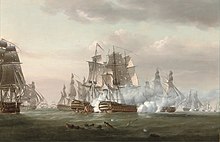Spanish shipMonarca(1794)

TheMonarcawas a 74-gunthird-rateship of the lineof theSpanish Navy.She was ordered by a royal order of 28 September 1791, built in theReales Astilleros de Esteiroshipyard and launched on 17 March 1794. Designed byJosé Romero Fernández de Landaand belonging to theSan Ildefonsoclass,her main guns were distributed along two complete decks, with twenty-eight 24-pounders in her first battery (lower deck) and thirty 18-pounders in her second battery (upper deck). Additionally on completion she had ten 8-pounders on her quarterdeck and six 8-pounders on her forecastle, although these guns were altered during her life.
History[edit]
She underwent proving trials between September and November 1794 alongside theMontañés,also launched in 1794 but designed by Julián Martín de Retamosa (Romero de Landa's successor), aiming to work out whose method of construction was best. The trials were overseen by José Justo Salceno and the results favoured theMontañés.TheMonarcawas assigned toJuan de Lángara's squadron, taking part in the defence ofRoses.


She took part in thebattle of Trafalgaron 21 October 1805 under the command of Captain Teodoro Argumosa y Bourke. She was attacked at close range byMarsandTonnantas they first cut the Franco-Spanish line. The ship behind theTonnant,theBellerophon,slipped under her stern at 12:30 and fired two broadsides into her. She was heavily damaged, with 100 men killed and 150 wounded. A party of 55Royal Marinescaptured the ship, but the night after the battle the surviving Spanish crew overpowered them and cast them adrift, leaving them to the mercy of the storm that night.
On 24 October the survivors decided to try to repair the ship's rudder and return toCádiz,as the weather was improving, but an hour later they were pursued byLeviathan,which also picked up the marines and some Spanish survivors of the storm. On 28 October the ship ran aground on the Arenas Gordas coast nearHuelva,betweenTorre de la HigueraandTorre del Asperillo,leaving it lying on its side. On 31 October she was destroyed by the guns of the frigateNaiadto avoid her being reused or refloated.
See also[edit]
References[edit]
Bibliography[edit]
- Arturo Pérez-Reverte,Cabo Trafalgar,Alfaguara, 2004.
- Winfield, Rif; Tredrea, John M; García-Torralba Pérez, Enrique & Blasco Felip, Manuel (2023).Spanish Warships in the Age of Sail 1700—1860: Design, Construction, Careers and Fates.Barnsley, UK: Seaforth Publishing.ISBN978-1-5267-9078-1.
External links[edit]
- Todo a Babor. Monarca (2)
- Spanish Ships at Trafalgar
- Spanish soldiers and sailors at Trafalgar (1)by Luís Aragón Martín
- Spanish soldiers and sailors at Trafalgar (2)by Luís Aragón Martín
- José Romero Fernández de Landa, Un Ingeniero de Marina del Siglo XVIII, by José María de Juan-García Aguado, Universidade da Coruña, 1998.
- List of Spanish ships built at Esteiro
External links[edit]
 Media related toMonarca (ship, 1794)at Wikimedia Commons
Media related toMonarca (ship, 1794)at Wikimedia Commons
